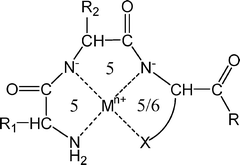Metal ion selectivity of oligopeptides
Abstract
Metal binding affinity and selectivity of peptides are reviewed with a special emphasis on the high structural variety of peptide complexes. The most common structural type of these complexes is built up by the deprotonation and metal ion coordination of subsequent amide groups in the form of fused five-membered chelate rings. The metal ion selectivity of this process and the role of various anchoring groups are discussed in detail. The highest metal binding affinity of peptides is connected to the presence of two anchoring groups in appropriate location (the “double anchor”): e.g. the NH2-Xaa-Xaa-His/Cys/Asp/Met-Xaa sequence. Among the side chain donor functions, the imidazole of histidyl and thiolate of cysteinyl residues are the most effective ligating groups and their involvement in metal binding results in a great variety of different macrochelate or loop structures and/or formation of various polynuclear complexes. Examples of these structural motifs and their possible applications have been thoroughly discussed.


 Please wait while we load your content...
Please wait while we load your content...